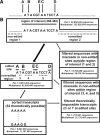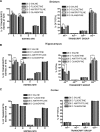Assessing serotonin receptor mRNA editing frequency by a novel ultra high-throughput sequencing method
- PMID: 20185571
- PMCID: PMC2879535
- DOI: 10.1093/nar/gkq107
Assessing serotonin receptor mRNA editing frequency by a novel ultra high-throughput sequencing method
Abstract
RNA editing is a post-transcriptional modification of pre-mRNA that results in increased diversity in transcriptomes and proteomes. It occurs in a wide variety of eukaryotic organisms and in some viruses. One of the most common forms of pre-mRNA editing is A-to-I editing, in which adenosine is deaminated to inosine, which is read as guanosine during translation. This phenomenon has been observed in numerous transcripts, including the mammalian 5-HT(2C) receptor, which can be edited at five distinct sites. Methods used to date to quantify 5-HT(2C) receptor editing are labor-intensive, expensive and provide limited information regarding the relative abundance of 5-HT(2C) receptor editing variants. Here, we present a novel, ultra high-throughput method to quantify 5-HT(2C) receptor editing, compare it to a more conventional method, and use it to assess the effect of a range of genetic and pharmacologic manipulations on 5-HT(2C) editing. We conclude that this new method is powerful and economical, and we provide evidence that alterations in 5-HT(2C) editing appear to be a result of regional changes in brain activity, rather than a mechanism to normalize 5-HT(2C) signaling.
Figures




Similar articles
-
Quantitative analysis of 5HT(2C) receptor RNA editing patterns in psychiatric disorders.Neurobiol Dis. 2012 Jan;45(1):8-13. doi: 10.1016/j.nbd.2011.08.026. Epub 2011 Sep 3. Neurobiol Dis. 2012. PMID: 21914481 Free PMC article. Review.
-
An innovative real-time PCR method to measure changes in RNA editing of the serotonin 2C receptor (5-HT(2C)R) in brain.J Neurosci Methods. 2009 May 15;179(2):247-57. doi: 10.1016/j.jneumeth.2009.01.027. Epub 2009 Feb 7. J Neurosci Methods. 2009. PMID: 19428534 Free PMC article.
-
Quantification of RNA editing of the serotonin 2C receptor (5-HT(₂C)R) ex vivo.Methods Enzymol. 2010;485:311-28. doi: 10.1016/B978-0-12-381296-4.00018-X. Methods Enzymol. 2010. PMID: 21050925
-
High-throughput multiplexed transcript analysis yields enhanced resolution of 5-hydroxytryptamine 2C receptor mRNA editing profiles.Mol Pharmacol. 2010 Jun;77(6):895-902. doi: 10.1124/mol.109.061903. Epub 2010 Feb 24. Mol Pharmacol. 2010. PMID: 20181818 Free PMC article.
-
Measuring RNA editing of serotonin 2C receptor.Biochemistry (Mosc). 2011 Aug;76(8):912-4. doi: 10.1134/S0006297911080062. Biochemistry (Mosc). 2011. PMID: 22022964 Review.
Cited by
-
A unique gene expression signature associated with serotonin 2C receptor RNA editing in the prefrontal cortex and altered in suicide.Hum Mol Genet. 2014 Sep 15;23(18):4801-13. doi: 10.1093/hmg/ddu195. Epub 2014 Apr 29. Hum Mol Genet. 2014. PMID: 24781207 Free PMC article.
-
International Union of Basic and Clinical Pharmacology. CX. Classification of Receptors for 5-hydroxytryptamine; Pharmacology and Function.Pharmacol Rev. 2021 Jan;73(1):310-520. doi: 10.1124/pr.118.015552. Pharmacol Rev. 2021. PMID: 33370241 Free PMC article. Review.
-
Serotonin 2c receptor RNA editing in major depression and suicide.World J Biol Psychiatry. 2013 Dec;14(8):590-601. doi: 10.3109/15622975.2011.630406. Epub 2012 Mar 9. World J Biol Psychiatry. 2013. PMID: 22404657 Free PMC article.
-
RNA recoding in cephalopods tailors microtubule motor protein function.Cell. 2023 Jun 8;186(12):2531-2543.e11. doi: 10.1016/j.cell.2023.04.032. Epub 2023 Jun 8. Cell. 2023. PMID: 37295401 Free PMC article.
-
Quantitative analysis of 5HT(2C) receptor RNA editing patterns in psychiatric disorders.Neurobiol Dis. 2012 Jan;45(1):8-13. doi: 10.1016/j.nbd.2011.08.026. Epub 2011 Sep 3. Neurobiol Dis. 2012. PMID: 21914481 Free PMC article. Review.
References
-
- Benne R, Van den Burg J, Brakenhoff JP, Sloof P, Van Boom JH, Tromp MC. Major transcript of the frameshifted coxII gene from trypanosome mitochondria contains four nucleotides that are not encoded in the DNA. Cell. 1986;46:819–826. - PubMed
-
- Keegan LP, Gallo A, O'Connell MA. The many roles of an RNA editor. Nat. Rev. Genet. 2001;2:869–878. - PubMed
-
- Sommer B, Kohler M, Sprengel R, Seeburg PH. RNA editing in brain controls a determinant of ion flow in glutamate-gated channels. Cell. 1991;67:11–19. - PubMed
-
- Palladino MJ, Keegan LP, O'Connell MA, Reenan RA. A-to-I pre-mRNA editing in Drosophila is primarily involved in adult nervous system function and integrity. Cell. 2000;102:437–449. - PubMed
Publication types
MeSH terms
Substances
Grants and funding
LinkOut - more resources
Full Text Sources
Other Literature Sources

